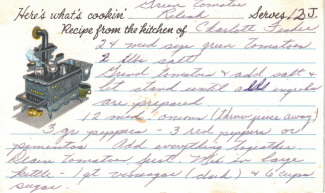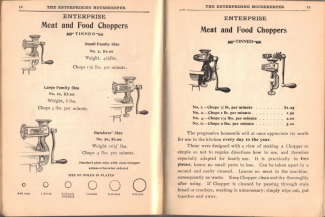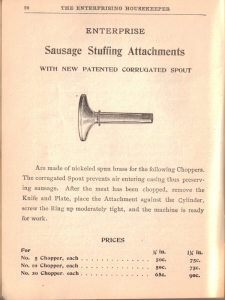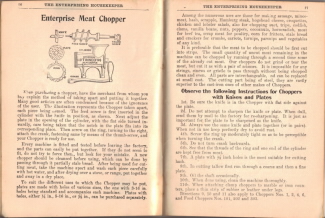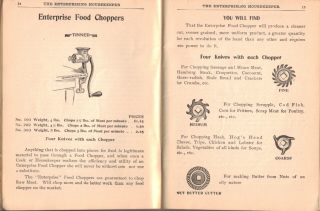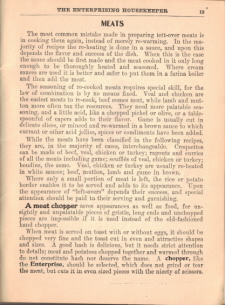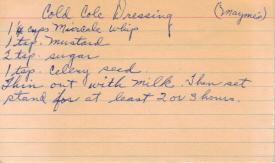Handwritten recipe for Green Tomato relish, found in an old box of recipes. The recipe is below, typed as-is, you can click the picture to view a larger copy of the original, recipe is typed beneath it.
Before using this recipe, it’s important to read this page, the “Safe Canning & Food Preservation” section.
Green Tomato Relish
Serves: 12 J.
24 med size green tomatoes
2 tlbs salt*
Grind tomatoes & add salt & let stand until all ingreds are prepared.
12 med. onions (throw juice away)
3 gr peppers – 3 red peppers or pimentos.
Add everything together. Drain tomatoes first. Mix in large kettle – 1 qt vinegar (dark) & 6 cups sugar.
Let mixture get hot then add drained tomatoes & remaining ingreds. Bring to rolling boil for 10 mins.
Add box of pickling spices (tie in cloth while cooking).
Keep hot while filling jars.
*This part isn’t clear on the recipe but I believe it’s tlbs for tablespoons of salt
This is a recipe clipping from a magazine, date unknown. You’ll find the recipe posted underneath the picture.
Before using this recipe, it’s important to read this page, the “Safe Canning & Food Preservation” section.
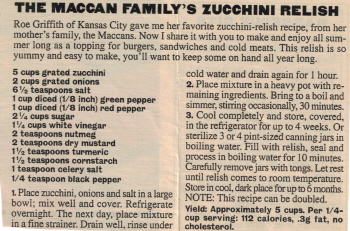
Roe Griffith of Kansas City gave me her favorite zucchini-relish recipe, from her mother’s family, the Maccans. Now I share it with you to make and enjoy all summer long as a topping for burgers, sandwiches and cold meats. This relish is so yummy and easy to make, you’ll want to keep some on hand all year long.
The Maccan Family’s Zucchini Relish
5 cups grated zucchini
2 cups grated onions
6 1/2 teaspoons salt
1 cup diced (1/8 inch) green pepper
1 cup diced (1/8 inch) red pepper
2 1/4 cups sugar
1 1/4 cups white vinegar
2 teaspoons nutmeg
2 teaspoons dry mustard
1 1/2 teaspoons turmeric
1 1/2 teaspoons cornstarch
1 teaspoon celery salt
1/4 teaspoon black pepper
- Place zucchini, onions and salt in a large bowl; mix well and cover. Refrigerate overnight. The next day, place mixture in a fine strainer. Drain well, rinse under cold water and drain again for 1 hour.
- Place mixture in a heavy pot with remaining ingredients. Bring to a boil and simmer, stirring occasionally, 30 minutes.
- Cool completely and store, covered, in the refrigerator for up to 4 weeks. Or sterilize 3 or 4 pint-sized canning jars in boiling water. Fill with relish, seal and process in boiling water for 10 minutes. Carefully remove jars with tongs. Let rest until relish comes to room temperature. Store in cool, dark place for up to 6 months.
NOTE: This recipe can be doubled.
Yield: Approximately 5 cups
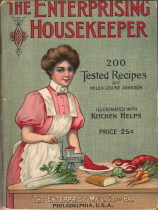 Here are pages 18, 19 and 20 from the vintage booklet The Enterprising Housekeeper from the sixth edition (1906). These are mainly scans of the pages that have a few different illustrations of antique choppers, but some notes are typed out as well.
Here are pages 18, 19 and 20 from the vintage booklet The Enterprising Housekeeper from the sixth edition (1906). These are mainly scans of the pages that have a few different illustrations of antique choppers, but some notes are typed out as well.
Enterprise Meat and Food Choppers
The progressive housewife will at once appreciate its worth for use in the kitchen every day in the year.
These were designed with a view of making a Chopper so simple as not to require directions how to use, and therefore especially adapted for family use. It is practically in two pieces, hence no small parts to lose. Can be taken apart in a second and easily cleaned. Leaves no meat in the machine, consequently no waste. Keep Chopper clean and dry thoroughly after using. If Chopper is cleaned by passing through stale bread or crackers, washing is unnecessary; simply wipe out, put together and away.
Sausage Stuffing Attachments
Are made of nickeled spun brass for the following Choppers. The corrugated Spout prevents air entering casing thus preserving sausage. After the meat has been chopped, remove the Knife and Plate, place the Attachment against the Cylinder, screw the Ring up moderately tight, and the machine is ready for work.
 Here are pages 16 and 17 of the vintage booklet The Enterprising Housekeeper from the sixth edition (1906). If you’d like to follow along and browse through more pages of the book, I’m filing them in the Enterprising Housekeeper Category.
Here are pages 16 and 17 of the vintage booklet The Enterprising Housekeeper from the sixth edition (1906). If you’d like to follow along and browse through more pages of the book, I’m filing them in the Enterprising Housekeeper Category.
Enterprise Meat Chopper
When purchasing a chopper, have the merchant from whom you buy explain the method of taking apart and putting it together. Many good articles are often condemned because of the ignorance of the user. The illustration represents the Chopper taken apart, each piece being named. The feed screw is first inserted in the cylinder with the knife in position, as shown. Next adjust the plate in the opening of the cylinder, with the flat side turned inwardly, care being taken that the notch in the plate fits into its corresponding place. Then screw on the ring, turning to the right, attach the crank, fastening same by means of the thumb-screw, and your Chopper is ready for use.
Every machine is fitted and tested before leaving the factory, and the parts can easily be put together. If they do not seem to fit, do not try to force them, but look for your mistake. A new chopper should be cleansed before using, which can be done by passing through it partially stale bread. After being used for cutting meat, take the machine apart and wash each piece carefully with hot water, and after drying over a stove, or range, put together and away in a dry place.
To suit the different uses to which the Chopper may be put, plates are made with holes of various sizes, the one with 3-16 in. holes being standard and accompanies each machine. Plates with holes, either 1/4 in. 5-16 in., or 3/8 in., can be purchased separately.
Among the numerous uses are those for making sausage, mincemeat, hash, scrapple, Hamburg steak, hogshead cheese, croquettes, chicken and lobster salads, also for chopping suet, tripe, codfish, clams, vanilla beans, nuts, peppers, cocoanuts, horseradish, meat for beef tea, scrap meat for poultry, corn for fritters, stale bread and crackers for crumbs, carrots, turnips, parsnips and vegetables of any kind.
It is preferable that the meat to be chopped should be first cut into strips. The small quantity of uncut meat remaining in the machine can be chopped by running through a second time some of the already cut meat. Our choppers do not grind or tear the meat, but cut it as with a pair of scissors. It is impossible for any strings, sinews or gristle to pass through without being chopped clean and even. All parts are interchangeable, and can be replaced at small cost. The cutting part being of steel, they are vastly superior to the cast-iron ones of other makes of Choppers.
Observe the following Instructions for Choppers with Knives and Plates
1st. Be sure the knife is in the Chopper with flat side against the plate.
2d. Do not attempt to sharpen the knife or plate. When dull, send them by mail to the factory for re-sharpening. It is just as important for the plate to be sharpened as the knife.
3d. Always use the same knife and plate together (or in pairs). When not in use keep perfectly dry to avoid rust.
4th. Screw the ring up moderately tight so as to be perceptible when turning the crank.
5th. Do not turn crank backwards.
6th. See that the threads of the ring and one end of the cylinder are kept free from meat.
7th. A plate with 3/8 inch holes is the most suitable for cutting hash.
8th. In cutting tallow first run through a coarse and then a fine plate.
9th. Oil the shaft occasionally.
10th. When done using, clean the machine thoroughly.
11th. When attaching clamp choppers to marble or iron counters, place a thin strip of rubber or leather under legs.
Directions 9, 10 and 11 also apply to Choppers Nos. 1, 2, 4, 6 and Food Choppers Nos. 101, 202 and 303.
 Here are pages 14 and 15 of the antique booklet The Enterprising Housekeeper, sixth edition (1906). If you’d like to follow along and browse through more pages of the book, I’m filing them in the Enterprising Housekeeper Category.
Here are pages 14 and 15 of the antique booklet The Enterprising Housekeeper, sixth edition (1906). If you’d like to follow along and browse through more pages of the book, I’m filing them in the Enterprising Housekeeper Category.
Enterprise Food Choppers
Anything that is chopped into pieces for food is legitimate material to pass through a Food Chopper, and when once a Cook or Housekeeper realizes the efficiency and utility of an Enterprise Food Chopper she will never be without one nor use a substitute.
The “Enterprise” Food Choppers are guaranteed to chop Raw Meat. Will chop more and do better work than any food chopper on the market.
You Will Find
That the Enterprise Food Chopper will produce a cleaner cut, evener grained, more uniform product, a greater quantity for each revolution of the hand than any other and requires less power to do it.
Four Knives with each Chopper
Fine
For Chopping Sausage and Mince Meat, Hamburg Steak, Croquettes, Cocoanut, Horse-radish, Stale Bread and Crackers for Crumbs, etc.
Medium
For Chopping Scrapple, Cod Fish, Corn for Fritters, Scrap Meat for Poultry, etc., etc.
Coarse
For Chopping Hash, Hog’s Head Cheese, Tripe, Chicken and Lobster for Salads, Vegetables of all kinds for Soups, etc., etc.
Nut Butter Cutter
For making Butter from Nuts of an oily nature.
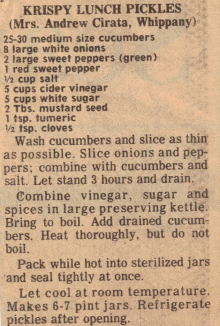 Here is an old recipe clipping from an unknown newspaper, no date.
Here is an old recipe clipping from an unknown newspaper, no date.
Before using this recipe, it’s important to read this page, the “Safe Canning & Food Preservation” section.
Krispy Lunch Pickles
25-30 medium size cucumbers
8 large white onions
2 large sweet peppers (green)
1 red sweet pepper
1/2 cup salt
5 cups cider vinegar
5 cups white sugar
2 TBS mustard seed
1 tsp tumeric
1/2 tsp. cloves
Wash cucumbers and slice as thin as possible. Slice onions and peppers; combine with cucumbers and salt. Let stand 3 hours and drain.
Combine vinegar, sugar and spices in large preserving kettle. Bring to boil. Add drained cucumbers. Heat thoroughly, but do not boil.
Pack while hot into sterilized jars and seal tightly at once.
Let cool at room temperature. Makes 6-7 pint jars. Refrigerate pickles after opening.
 This is page 13 from the antique booklet The Enterprising Housekeeper, sixth edition (1906). If you’d like to follow along and browse through more pages of the book, I’m filing them in the Enterprising Housekeeper Category.
This is page 13 from the antique booklet The Enterprising Housekeeper, sixth edition (1906). If you’d like to follow along and browse through more pages of the book, I’m filing them in the Enterprising Housekeeper Category.
The most common mistake made in preparing left-over meats is in cooking them again, instead of merely re-warming. In the majority of recipes the re-heating is done in a sauce, and upon this depends the flavor and success of the dish. When this is the case the sauce should be first made and the meat cooked in it only long enough to be thoroughly heated and seasoned. Where cream sauces are used it is better and safer to put them in a farina boiler and then add the meat.
The seasoning of re-cooked meats requires special skill, for the law of combination is by no means fixed. Veal and chicken are the easiest meats to re-cook, beef comes next, while lamb and mutton more often tax the resources. They need more palatable seasoning, and a little acid, like a chopped pickle or olive, or a tablespoonful of capers adds to their flavor. Game is usually cut in delicate slices, or minced and re-warmed in a brown sauce to which currant or other acid jellies, spices or condiments have been added.
While the meats have been classified in the following recipes, they are, in the majority of cases, interchangeable. Croquettes can be made of beef, veal, chicken or turkey; ragouts and curries of all the meats including game; soufflés of veal, chicken or turkey; boudins, the same. Veal, chicken or turkey are usually re-heated in white sauces; beef, mutton, lamb and game in brown.
Where only a small portion of meat is left, the rice or potato border enables it to be served and adds to its appearance. Upon the appearance of “left-overs” depends their success, and special attention should be paid to their serving and garnishing.
A meat chopper saves appearances as well as food, for unsightly and unpalatable pieces of gristle, long ends and unchopped pieces are impossible if it is used instead of the old-fashioned hand chopper.
When meat is served on toast with or without eggs, it should be chopped very fine and the toast cut in even and attractive shapes and sizes. A good hash is delicious, but it needs strict attention to details; meat and potatoes chopped together and warmed through do not constitute hash nor deserve the name. A chopper, like the Enterprise, should be selected, which does not grind or tear the meat, but cuts it in even sized pieces with the nicety of scissors.
This recipe is written on an index card and is quite yellowed with age. The recipe title on the card is “Cold Cole Dressing”, this is a recipe for Cole Slaw dressing. There is also a name written in brackets in the top right corner, I believe this refers to the person who shared this recipe. There was a misspelling that I corrected.
Cold Cole Dressing (Mayme’s)
1 1/4 cups Miracle Whip
1 tsp mustard
2 tsp sugar
1 tsp celery seed
Thin out with milk. Then set stand for at least 2 or 3 hours.

